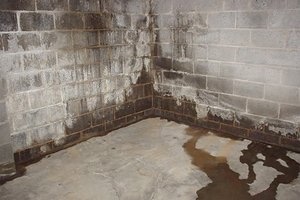
As is evident in the photo to the left, the concrete masonry wall (CMU) is exhibiting the phenomena known as efflorescence (a white powdery alkaline sulfite solution). This may be a common sight in your basement or garage. If it is, it is due to the water soluble salts deposited on the masonry as the water evaporates. This is indicative of unacceptable levels of moisture in the CMU wall cavity. Simply put, if no moisture reaches the sulfites, then they cannot be rendered into solution and migrate to the surface.
Basement water intrusion can be a tricky thing. Typical sources of the water are insufficient roof eaves, lacking gutters and improper downspout management, sprinkler malfunctions, landscape edging “dams,” and most importantly improper grading. Window wells, underground springs, and a high water table are some others. In order to prevent the problem, it is preferable to attack the source; do not attempt to seal up the foundation wall from the inside, it is more advantageous to address the water before it enters the cavity. This would require ensuring the gutters are properly in place and clear, the ground topography slopes away from the building, and the existing soil is not problematic (i.e. clayey soils which are highly saturated and prone to hydrostatic pressure against the wall). Swales, underground drainage systems, and possibly a cut-off trench usually remedy the situation.
When all else fails, an interior trench drain can solve the problem. A qualified water intrusion contractor would be able to help you with this, but it can be expensive. It is best to try the other strategies mentioned above, before contemplating cutting into your basement slab. Certainly cracks in the foundation walls provide the easiest path of intrusion; those should be tackled first, but may be due to something bigger See: Basement Wall Cracks
BLSH&E can ascertain the issues and recommend a solution. Call me today for a free phone consultation. As with all of my engineering consultation/designs, you will be presented with a detailed written proposal of the Scope of Work for your review, including fee, prior to commencing.
Oh, and by the way, applying tar to the outside foundation is merely dampproofing, NOT waterproofing. Use fabrics or plastics barriers, coupled with a channel to drain water to a footing drain, to properly prevent groundwater from entering in the first place.